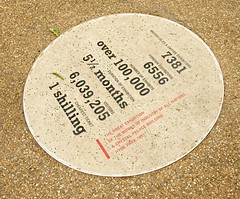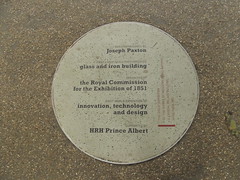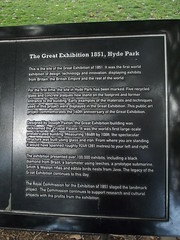Great Exhibition
Commemorated on 4 plaques
British Isles & Empire exhibitors 7381 Foreign exhibitors 6556 Number of exhibits over 100,000 Duration of the exhibition 5 ½ months Visitors 6,039,205 Cheapest ticket 1 shilling
Hyde Park, London, United Kingdom where it sited
Project funded by public subscription Cost of building and fittings £200,000 Value of exhibits (excluding Koh-I-Noor diamond) £2 million Profits £186,437 Profits fund site for cultural insitutions on Exhibition Road
Hyde Park, London, United Kingdom where it sited (1851)
Building designed by Joseph Paxton First large scale prefabricated glass and iron building Organised by the Royal Commission for the Exhibition of 1851 First world exposition of innovation, technology and design Supported by HRH Prince Albert
Hyde Park, London, United Kingdom where it sited (1851)
The Great Exhibition 1851, Hyde Park This is the site of the Great Exhibition of 1851. It was the first world exhibition of design, technology and innovation, displaying exhibits from Britain, the British Empire and the rest of the world. For the first time, the site in Hyde Park has been marked. Five recycled glass and concrete plaques now stand on the footprint and former entrance to the building. Early examples of the materials and techniques used in this project were displayed in the Great Exhibition. This public art project commemorates the 160th anniversary of the Great Exhibition. Designed by Joseph Paxton, the Great Exhibition building was nicknamed the 'Crystal Palace'. It was the world's first large-scale prefabricated building. Measuring 1848ft by 108ft, the spectacular structure was built using glass and iron. From where you are standing, it would have spanned roughly 924ft (281 metres) to your left and right. The exhibition presented over 100,000 exhibits, including a black diamond from Brazil, a barometer using leeches, a prototype submarine. Smith & Weston rifles and edible birds nests from Java. The legacy of the Great Exhibition continues to this day. The Royal Commission for the Exhibition of 1851 staged the landmark project. The Commission continues to support research and cultural projects with the profits from the exhibition.
Hyde Park, London, United Kingdom where it sited (1851)




